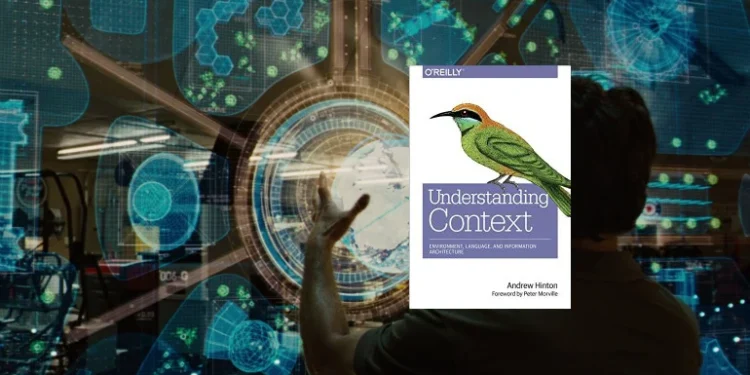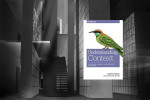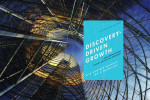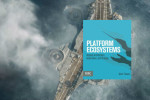Understanding Context

Context consists of three modes of information: physical, semantic, and digital. Each of these structures has its own dynamics, discovery methods, modes of understanding, and ways of knowing.
Understanding Context: Environment, Language, and Information Architecture by Andrew Hinton
This book takes readers on an extended journey through the structure and components of context. Hinton describes each layer of context, devoting several chapters to each, and brings in a variety of theories which provide entry points for each. Hinton covers a lot of ground and includes discussions of biology, linguistics, semiology, psychology, information theory, and cognition.
What is context?
The fundamental model he presents is that of an agent attempting to take action with an environment that must be understood. Context is defined as “an agent’s understanding of the relationships between the elements of the agent’s environment.” Hinton points out that as more and more of our lives are lived in the digital realm, we become removed from the more obvious and/or learnable affordances of the physical real.
What place am I in? What objects does it contain, and how do the work? Who am I, and who can see me, and what am I doing? What used to be clear is now less so.
A Trip to the Airport
Hinton begins the book with a description of a short trip to the airport where he encounters layers of meaning and information. During the journey, he’s trying to navigate the physical environment and find the TSA pre-check line and his gate. There’s a self-serve kiosk to contend with along with gate changes and departure information on overhead displays. He’s also using his mobile phone in several modes: apps, notifications, and email. He has a calendar with schedule entries that overlap his personal and professional lives. He is represented in these various systems and context by his name, frequent flier id, loyalty program category, passport attributes, and the implications of these designations to his boarding time and travel benefits. Further, each context is related to the others in some manner which must also be discovered and understood. As a traveler, he must situated himself within these overlapping contexts and understand them sufficiently to meet his goal of catching his flight on time. He projects this scenario forward several years when the Internet of Things imbues even more physical objects with semantic and digital interfaces, meanings, and entanglements.
Modes of Information
The physical mode represents the information that a living creature uses to “ecologically” understand its environment. The semantic mode equates to language and is the way people communicate meaning to one another. The digital mode consists of the information that computers exchange with one another and does not include human readable data. The “upper” digital layer changes much more quickly than the “lower” physical and perceptual level, which is effectively limited by human biology.
The Physical Mode
cognition is truly environment-first, emerging from an active relationship between environment, body, and brain
Hinton uses James G. Gibson’s ecological psychology as the basis of describing the physical mode of information. According to ecological psychology, humans and animals “directly perceive and act in the world by their bodies’ ability to detect information about the structures in the environment.” This direct bodily perception and awareness enables us to make sense of the world, move within it effectively, and use its objects to achieve our goals. Embodied cognition contradicts the popular mainstream view of perception as residing in the brain with the body only serving input and output functions.
Embodiment aligns well with user experience design because it includes “the experiential reality of the user as a primary input to design rather than relying on the goals of a business or the needs of a technology.” Hinton also discusses Antonio Damasio’s findings that body, mind, reason, and emotion are an interconnected system, not separate components.
Another counterintuitive idea that Hinton discusses is memory, which is important for understanding how we understand. Memory, typically thought in data bank metaphor, is not a direct storage and access mechanism. He calls memory “more of a verb than a noun.” It is a dynamic process that alters information as it touches it.
Hinton affirms Don Norman and Jakob Nielsen’s admonition to minimize cognitive load and instead put information directly in the environment for those who will inhabit and work with your designs.
The Semantic Mode
Semantic information is what we add to the environment to make it even more relevant and useful for humans
People swim in a sea of language and symbols. Meaning is encoded in various types of containers and providing the right amount of information is one of the designer’s chief challenges. Like the physical mode, the semantic mode is based on the body. Metaphors and common ways of describing the word originate in bodily sensations and structures. Words like “get”, “set”, and “put” have been transferred to the digital realm and have meaning there based on their physical counterparts.
The Digital Mode
Human memory is embodied and only occasionally somewhat literal (when we explicitly memorize something). But computer memory works by making exact copies of abstract representations. Computers don’t find their way to abstraction from the roots of physical perception-and-action; they begin with abstraction.
While humans can be ambiguous and hazily general, computers are always literal. Hinton discusses these two modes of representation and understanding in the context of the way humans approximate and satisfice, while computers require discrete and logical categorization and meaning. This gap creates challenges for designing digital experiences and environments.
Modes are a specific to digital systems and interfaces, but do not exist in nature. Forgetting and mis-understanding modes leads to a lot of confusion and errors with digital systems. Likewise, humans tend to “forage” for information rather than seek it in logical, linear fashion. These differences contribute to the frequent disconnect when people use software.







